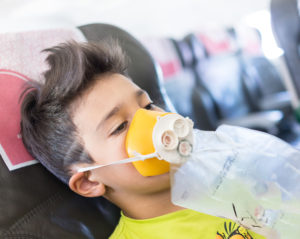
Oxygen mask be correctly worn over the mouth and nose
You have only 30 seconds left before losing consciousness!
Yes, this will be further reduced to 15 seconds if you are a senior citizen or moving around a lot when a plane is fully depressurized at 35,000 feet.
This answers Asmiati Utari’s question on “What happens when a plane loses air pressure?”.
Her query is not very specific but I am assuming a worst-case scenario of an explosive decompression and not a gradual depressurization.
How could you get knocked out within 30 seconds?
Well, basically, the percentage of oxygen in the air at 35,000 feet and at sea level is the same as at 21% but what changes is the air pressure outside the plane.
When we breathe at sea level, the atmospheric pressure is about 14.7 psi. This causes oxygen to easily pass through the lung membranes into the blood.
At 35,000 feet, the air pressure is at 3.46 psi. The air molecules which are further apart now makes it more difficult for oxygen to enter into your blood stream. This will lead to hypoxia or a lack of oxygen in your body tissues
35,000 feet is well over the “death zone” height of 26,000 feet. As such, climbers up Mount Everest at a height of 29,031 feet must carry oxygen along.
Hypoxia can arise when, for example, a bomb goes off and creates a hole at the back of the plane or, as in the Southwest Airlines Flight 1380 in 2018, one of the windows was punctured by external engine cowl fragments.
When a plane loses air pressure, air would rush out almost like a leaking balloon. A loud bang is heard with debris flying around, followed by fogging in the cabin.
An explosive decompression may be very uncomfortable due to ears ‘popping’ out with joint or stomach pain because of gas expansion. Small objects like phones and magazines or even people would be sucked out as had happened to one passenger on the Southwest Airlines flight.
A video of the scene after the emergency descent of the Southwest Airlines accident showed that almost none of the passengers had their oxygen masks correctly worn.
In my last posting on “Why people don’t listen to in-flight briefing”, I highlighted that passenger frequently do not pay attention to the inflight briefings.
Sure enough, the passengers in the above flight had the masks over the mouth only and not over both the mouth and nose. (See YouTube video below)
In the cockpit, a warning would sound when the cabin altitude passes 10,000 feet and the oxygen masks would drop down at around 14,000 feet. Soon after, the cabin pressure would equalize with the outside air pressure (3.46 psi) at 35,000 feet
The captain and the first officer would immediately put on their oxygen masks and perform an emergency descent to 10,000 feet where oxygen is no longer required.
This is what will happen when a plane loses air pressure in flight if it were due to an explosive decompression or rapid depressurization at 35.000 feet.
See YouTube video on The Proper Way to Use Oxygen Mask in Case of In-flight Emergency
here https://www.youtube.com/watch?v=Vfjt_KL6-m0
See YouTube video on Airbus A320 Emergency Descent here